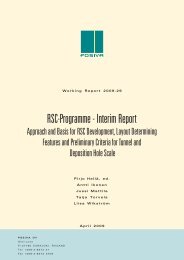Bentonite Mineralogy Part 1: Methods of Investigation - Posiva
Bentonite Mineralogy Part 1: Methods of Investigation - Posiva
Bentonite Mineralogy Part 1: Methods of Investigation - Posiva
Create successful ePaper yourself
Turn your PDF publications into a flip-book with our unique Google optimized e-Paper software.
63<br />
The Milos bentonites contain poorly crystalline smectite and the calculations gave too<br />
high percentages <strong>of</strong> calcite and pyrite. Both could be corrected using chemical data<br />
(Table 7 -16). The activated Milos bentonite contains an appreciable amount <strong>of</strong> quartz.<br />
The quartz content cannot be calculated using chemical data because smectites are<br />
silicate minerals. The percentages given for sample Milos A in table 7-15 are not much<br />
more than a guess. Other methods need to be used for that sample. The same is true for<br />
the Friedland sample. There are no factors determined for mixed-layer minerals.<br />
All the Czech samples contain a considerable amount <strong>of</strong> iron oxides. Only a small part<br />
<strong>of</strong> iron is bound to octahedral sheets <strong>of</strong> the smectite/mixed-layer mineral. The iron<br />
oxide as well as the calcite contents could be corrected using chemical data (Table<br />
7-16). According to Lego et al. (1995), ea 50% <strong>of</strong>total iron in the< 2 J.lm fraction <strong>of</strong> the<br />
Rokle bentonite is as goethite. According to FTIR data, octahedral sheets <strong>of</strong> the Rokle<br />
smectite contain more iron than the octahedral sheets <strong>of</strong> other Czech smectites (Fig.<br />
7-13, Appendix 4). The smectite content <strong>of</strong> the Rokle bentonite suggested in table 7-15<br />
is probably too high. The first calculations gave percentages around 60 but were based<br />
on over-estimation <strong>of</strong> calcite and iron oxide content. The smectite/kaolinite ratio is not<br />
easily determined. Both minerals are poorly ordered and have broad XRD peaks. It is<br />
probable that the Rokle sample contains mainly smectite or a smectitic mixed-layer<br />
mineral, as does the Strance sample. The Skalna and Dnesice samples contain mainly<br />
kaolinite. According to FTIR data, the proportion <strong>of</strong>kaolinite increases in order Rokle<br />
Strance- Skalna- Dnesice.

















